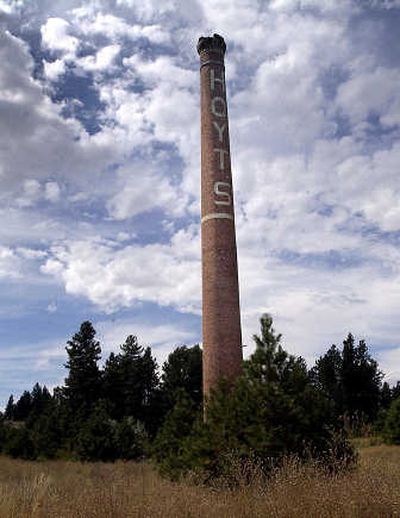Garden Springs smokestack remnant of Hoyt Brothers Floral Co.

It may look like just a big old chimney or smokestack there off the Garden Springs exit of Interstate 90 west of the city, but it’s really a remnant of some quite interesting history involving flowers and Italian immigrants in Spokane.
The name Hoyt is clearly visible on the chimney, which is all that remains of the old Hoyt Brothers Floral Co. which used to be located there. The Hoyt Brothers built the first of their six greenhouses at that site, a 30-by-50-foot building, in about 1900, according to a story in The Spokesman-Review celebrating 1940 as the golden jubilee year of the flower industry in Spokane.
The first Hoyt greenhouse was soon followed by another to accommodate rose production, with the Cupy candy store and Smith and Co. undertakers as the main customers. One of the brothers operated the facility where only the chimney now remains and the other had greenhouses nearby, where the Hampton Inn now stands. In 1905, the Hoyts opened a retail flower business in downtown Spokane, at Post and Riverside.
Interestingly, Spokane ranked fourth among cities west of the Mississippi River as a flower-shipping center in 1940, according to that same newspaper article. There were some 20 acres of flowers under glass at that time.
While the flower business was thriving, so was the growth of a group of workers at Hoyt who came to work in the greenhouses from the same rural area outside Milan, Italy, according to Kathleen Moncalvo. One of those men was her father-in-law, Severino Moncalvo, who purchased the Hoyt greenhouse operation at Garden Springs about 1929 after having worked there for a time, she recalls. Her husband Rudy, who is deceased, inherited the business about 1970 and operated it as a greenhouse for bedding plants and poinsettias.
The Moncalvos sold the company in 1983, and it was dismantled after that, with only the smokestack remaining. Joe Langretto, also from the Milan area, bought the greenhouse operation from the other Hoyt brother, the one at the Hampton Inn site, and operated it for a number of years as Sunnydale Greenhouse.
Louis Gandini was another of the men who came to Hoyts from outside Milan. He came in the early 1930s and worked there until he started his own business, Sunset Florists, according to his son Bob Gandini, current owner of Sunset Florists.
“I think what happened is that some of the men came to this area and worked at Hoyt and wrote back home to Italy about their lives here – and others came after them,” Gandini said. “They worked at Hoyt and eventually started their own flower businesses.”
Among them were Dominic Alice (Liberty Park Florists) and Angelo Lavagetto (Angelo’s Flowers, formerly located at 29th and Southeast Boulevard), Gandini said. He remembers that Frank Montecucco, another Milano émigré, came to Spokane and eventually set up his own greenhouse on East Fifth Avenue in the city; his son Max operated a greenhouse at 29th Avenue and Glenrose for many years.
One of the bonding events Kathleen Moncalvo remembers fondly when the Garden Springs facility was still in operation was how all the Italian flower families would gather at the site to celebrate events. The women would do the cooking and the men would be outside with their music and wine.
“Well, you know what it’s like when a bunch of Italians get together and drink wine and have a grand party,” she said. “It was quite something.”
Who could know, looking at that bare and isolated smokestack today, that it contains echoes of such a rich and colorful history of industry and family ties that helped make Spokane what it is today?